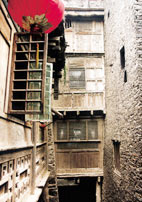|
About 170 kilometers west of Sichuan provincial capital Chengdu stands Taoping Village, home to the nomadic Qiang ethnic minority. Built in 111 BC, this ancient village has weathered 2,000 years of battles and besiegement.
On a nearby mountain slope stand two nine-story hexahedral blockhouses, or diaolou, in whose construction mathematics and geometry were obviously used. Despite their 30-meter height, they have survived erosion as well as frequent earthquakes.
The Qiang build their homes from stone, timber and mud, judging all measurements by eye, rather than using a design or plan, yet all buildings stand firm, straight and long. Although modest, Qiang dwellings are tastefully decorated with paintings and ceramic handicrafts. The average home has five stories and a narrow wooden staircase. Livestock is kept on the first floor, and the living room, bedrooms and kitchen are on the second. The third floor has more bedrooms and is used for storage. Grains are dried on the fourth floor and the fifth is a place of worship where white stones are arranged upon which to offer sacrifices.

The living room on the second floor has a wooden floor, and several wooden pillars support the roof. It is the appointed place for a shrine holding family idols or ancestral tablets. The focal point of the living room is the fireplace, made from stone slabs, where a fire burns the whole year round. On it stands a metal tripod flanked by steel woks and copper pots. Qiang families enjoy sitting around it, sipping wine in pleasant anticipation of typical meals, usually consisting of noodles, potatoes, tomatoes and green vegetables cooked over the crackling wood fire.
Wine is a main aspect of Qiang culture. It is made from highland barley and wheat and kept in a jar. Drinkers sit around the jar and take turns sipping wine through a bamboo tube. The fireplace is also where family and friends gather to celebrate weddings, births and festivals.
Another fascinating feature of Taoping is its complex and highly effective water network. Subterranean channels run beneath each street and house, enabling water to be fetched simply by lifting a stone slab. The sound of running water pervades, yet not a drop is in sight.

The village was built according to Taoist design with eight gates and 31 interconnecting corridors leading to each household in a maze-like manner. Villagers say that at times of war or siege these corridors provided a form of defense as they were used to move supplies and plan ambushes. The region's warlike history is apparent from the loopholes in each corridor wall. As one senior villager recalled, "As long as there were sufficient food reserves, we could defend our village for years."
Qiang people have a strong sense of the aesthetic, as can be seen from their everyday dress and ornamentation. They sew their own garments and footwear and embroider them with various motifs. Women's wear, from hats to shoes, is elaborately decorated with floral patterns, sometimes giving the impression that the scent of flowers emanates from the body of the wearer.
Their long tradition has endowed the Qiang minority with a rich cultural heritage. They are talented musicians, singers and dancers, and excel at the bamboo flute.
At folk festivals, the local people don their most colorful costumes, and perform rituals of slaughtering sheep, burning incense, and chanting incantations that express their gratitude to nature and prayers for a bountiful harvest and good luck for the coming year.
Qiang courtship rituals are solemn and intricate, starting with permission from both sides to court, to engagement, to the actual wedding ceremony of which wine drinking is an essential aspect.
Funerals are also complex as there are different ceremonies and manners of burial according to the deceased's age and cause of death. The ceremonial funeral dance has the martial aspect of an ancient battlefield, as the song of a shaman expresses the grief and mourning of the bereaved. The dead are buried in tombs on the mountain slope.
Tourism Information
Festivals: The Qiang New Year falls on the first day of the tenth lunar month. Celebrations last three to five days, during which sacrifices are made to the god of the heavens, the god of the mountain and the god of the village. Villagers then eat, drink and dance.
Food: Qiang people like medicinal dishes, particularly soup, that have specific functions for each organ.
Taboos: Qiang households should not be visited when a family member is sick, or if the wife is pregnant. Stepping over the fireplace is also taboo.
Shopping: Qiang women excel at embroidery, and Qiang embroidered wallets, handbags and local costumes make ideal souvenirs and gifts.
Click here to see local weather
Click here for reservation
(China Today June 4, 2004)
|

